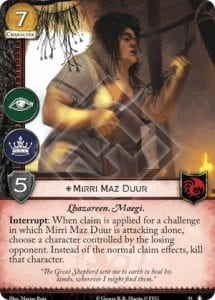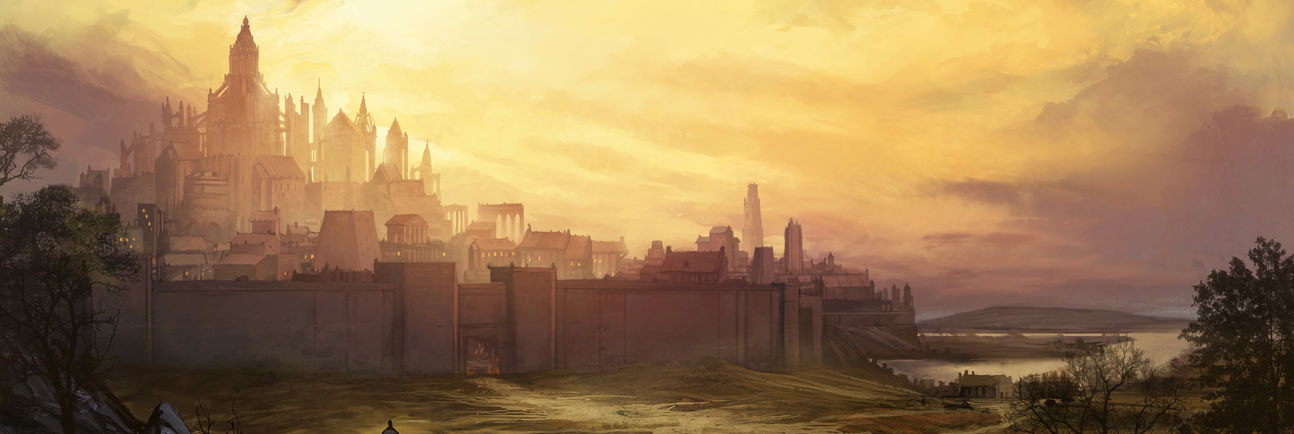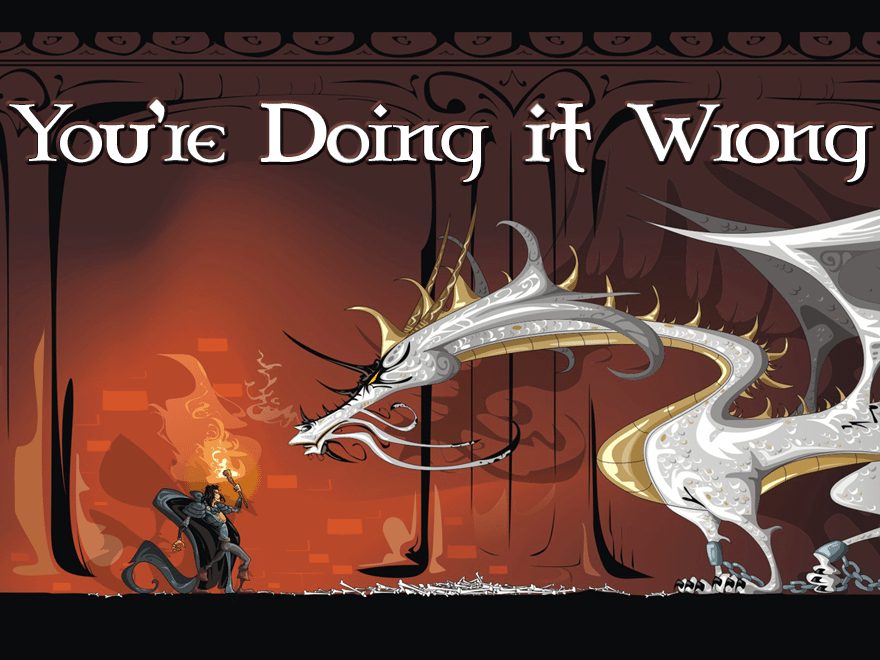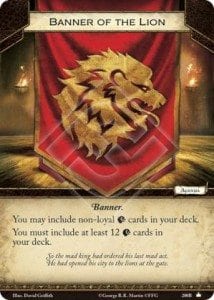by John Wright (handshaker6)
I don’t like duplicates. I don’t enjoy 7-cost, monster characters piling up renown and feeling invincible because you were fortunate enough to setup a matching pair of cards. It feels wrong that decks can get away with running a bunch of high-cost investments and still be able to fit in a bunch of events and negative attachments – setups, dead card draws, or something should punish this! Furthermore, I don’t like having choices in my plot deck determined primarily by their economic value instead of the way they can affect the game.
But I’m not here to whine about things I don’t like. I mean, it’s not like I don’t enjoy playing at the top-end of the curve sometimes. Thrones is Thrones, and Thrones is fun.
What I do want to do today is talk about my attempts to play a different way. Specifically, I’m giving details about a deck I’ve been developing and tweaking with my SoCal and Martell cohorts for months. But first…
Aggro vs. Tempo
Aggro
 Right now, AGOT is tilted heavily towards an aggro playstyle. Your exact definitions of what this term means may vary, but for my purposes it means the following: 1) put down large, impact characters; 2) protect those characters; 3) collect renown on these characters; and 4) remove your opponent’s impact characters from the game board. If you do these things, while winning a couple of power challenges along the way, you’re most likely going to win the game.
Right now, AGOT is tilted heavily towards an aggro playstyle. Your exact definitions of what this term means may vary, but for my purposes it means the following: 1) put down large, impact characters; 2) protect those characters; 3) collect renown on these characters; and 4) remove your opponent’s impact characters from the game board. If you do these things, while winning a couple of power challenges along the way, you’re most likely going to win the game.
Another set of observations about aggro in terms of deckbuilding. General deck composition tends to: 1) have as many expensive impact characters as possible; 2) run lots of cancel and/or saves; and 3) pack in lots of targeted kill. Whoever plays the most characters with renown and most effectively deals with incoming threats is the victor.
So when I say aggro, I almost exactly mean “big.” That is, build up your big threats,  which is where duplicates come into play. Because duplicates are now invincible, players are able to pour resources into having these impact characters hit the board; there is an extra layer of security in knowing that, even if your defenses slip, you still have an un-cancelable duplicate to protect that pile of renown.
which is where duplicates come into play. Because duplicates are now invincible, players are able to pour resources into having these impact characters hit the board; there is an extra layer of security in knowing that, even if your defenses slip, you still have an un-cancelable duplicate to protect that pile of renown.
In the game right now, there are only three non-burn effects which can remove duped characters from your opponent’s board: Wildfire Assault, Marched to the Wall, and Ghaston Grey. And that, my friends, is how I began to fall in love with House Martell – Martell, with their weak, little characters and total lack of renown. Martell, which didn’t even bother to include a 6 or 7 cost character in the core set. Martell, who with a simple attachment, can turn your Mountain into a corn-rowed Iron Throne…
But, I’m off-topic. We need to talk about tempo first.
Tempo
 Tempo, to me, is trying to stay one step ahead. Keep one more character on the board, keep one more card in hand, keep one more power on your faction card. To some extent, the quality of the characters on the board does not matter that much – the ultimate goal is really to get your opponent to the point where you can play Marched to the Wall and hit something important on her side while not losing anything significant on your own.
Tempo, to me, is trying to stay one step ahead. Keep one more character on the board, keep one more card in hand, keep one more power on your faction card. To some extent, the quality of the characters on the board does not matter that much – the ultimate goal is really to get your opponent to the point where you can play Marched to the Wall and hit something important on her side while not losing anything significant on your own.
Most often a tempo deck is going to run a lower cost curve. Maybe the deck can even skip over the 7-drops entirely. Maybe 6 starts to feel really expensive in a tempo build. Ideally, a tempo deck would also find ways to include extra draw in order to maximize the lower cost point for its characters. For whatever reason, Martell has not been given any draw to date, so we don’t have that as an option right now.
Tempo decks often need to find ways to slow down their opponent and  to get extra efficiency from its characters. A lower cost curve should open up extra slots in the plot deck to negatively impact your opponent since you don’t have to worry as much about generating economy. Moreover, characters that do double-duty will boost your tempo: strong come-into-play effects and the ability to participate in multiple challenges are highly valued.
to get extra efficiency from its characters. A lower cost curve should open up extra slots in the plot deck to negatively impact your opponent since you don’t have to worry as much about generating economy. Moreover, characters that do double-duty will boost your tempo: strong come-into-play effects and the ability to participate in multiple challenges are highly valued.
It’s hard to talk about it more without moving into specific card choices, but before we move on, here’s a one-sentence summary of what I’ve tried to present so far: aggro focuses on playing and removing specific characters, while tempo attempts to set a certain pace for the game as a whole.
Way back in February, I was fortunate to snag Martell in San Diego’s annual Thrones W.A.R. event. Jeff, Shaun, Frank and I delved deep into Martell decks, mixed with every possible banner. (Jeff really liked a Banner of the Watch deck for some reason – or maybe he was trolling me.) We came up with three really solid, diverse builds: Shaun played Rose, Jeff and Frank played Stag, and I got to play a deck Jeff and I had been toying with for some time, Martell-Lion. We did very well, finishing second to Targaryen by a single point.
And somehow, even though Sam Braatz won Worlds with Martell, even though we placed second in a perfectly faction-balanced environment, people still didn’t think Martell was any good until Tyene was printed.
At the time I didn’t fully understand what the deck was trying to do, but I knew it was good. Here is the early version of the Martell-Lion pairing we are discussing today: https://thronesdb.com/deck/view/49021
After Thrones W.A.R., Team Martell put the deck away for a while, but we were pretty sure of one thing: once The First Snow of Winter hit, this deck was going to be a monster.
As new packs came out, we added new cards and kept testing with the build. We kept it away from public game nights, trying to wait until a large enough tournament to re-debut the deck. That time was the end of April, when Shaun took his variation of Martell-Lion to KingdomCon and beat me in the finals. You can read about our match here, in which Shaun claims the #mamtap and costs me my beard: http://www.whitebookpodcast.com/youre-wrong-tourney-report-kingdomcon-2016/
It so happened that The People’s Champ himself happened to be watching Shaun’s victory over in Sweden via livestream, and soon after, Buzz was asking me some very good questions about the deck. He got a list together, including Shaun’s updated plot line, and proceeded to win a major Regional himself, which was also streamed. And suddenly our secret weapon was a force in the meta. It was a little bit of a bummer this happened before we could take it to a Regional tournament ourselves, but I will say I did enjoy each time I heard that a Martell-Lion took down another major event. It has also been really interesting to see the different permutations that others have taken the deck.
And so, now onto the deck I plan to bring to the SoCal Regional next week,* even though I think the meta may have already adjusted to it with extra Treacheries and Nightmares: The Litterbox (naming credit to Shaun).
Part 2 to follow…
*Editor’s Note: This event already happened. Our publication schedule is such that the readers benefit more from seeing John’s article series as a two-part narrative on successive days, rather than in weekly installments.



